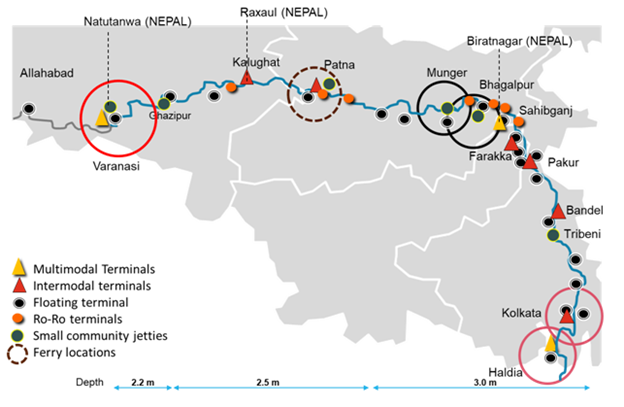Context
The Director General of the National Mission for Clean Ganga, spoke about the Arth Ganga model during his virtual keynote address to the Stockholm World Water Week 2022.
- Since 1991, World Water Week has been organised by the Stockholm International Water Institute to address global water concerns.
- The theme of 2022 is “Seeing the Unseen: The Value of Water”.

About
- PM Modi first introduced the concept during the first National Ganga Council meeting in Kanpur in 2019, where he urged for a shift from Namami Gange, the Union Government’s flagship project to clean the Ganga, to the model of Arth Ganga.
- The latter focuses on the sustainable development of the Ganga and its surrounding areas, by focusing on economic activities related to the river.
- At its core, the Arth Ganga model seeks to use economics to bridge people with the river.
- It strives to contribute at least 3% of the GDP from the Ganga Basin itself.
Arth Ganga Model
- The concept of Arth Ganga was introduced by the Prime Minister during the first National Ganga Council meeting in 2019.
- In the meeting, he suggested moving from Namami Gange to the Arth Ganga.
- Namami Gange was initiated to clean the Ganga river.
- Arth Ganga aims to promote the sustainable development of the Ganga river and its surrounding areas, by boosting economic activities associated with the river.
- According to the government ‘Arth Ganga” would catalyse economic development in the Ganga basin and also generate an economic benefit of more than Rs 1000 crores over the next 5 years.
- Under Arth Ganga, the government is working on six verticals-
- Zero Budget Natural Farming: Chemical-free farming on 10 km on both sides of the river.
- Promotion of cow dung as fertilizer through the GOBARdhan scheme.
- Monetization and Reuse of Sludge and Wastewater: Reuse treated water for irrigation, industries and revenue generation for Urban Local Bodies (ULBs).
- Livelihood Generation Opportunities, by encouraging people to sell local products.
- Increasing public participation by increasing cooperation between the stakeholders involved with the river.
- Promote the cultural heritage and tourism of Ganga and its surrounding area.
- Promote institutional building by empowering local administration for improved water governance.
Significance of the project
- The project is a holistic viewpoint of the Ganga rejuvenation project which seeks to promote sustainable livelihood of the population in this area.
- Inland Waterways being the most important part of the Arth Ganga project, will create huge economic activities while focusing on inclusive and sustainable livelihood.
- Trade and market access benefits, local community economic growth, and passenger convenience all have a big impact.
- According to the World Bank, this project’s infrastructure-related operations will lead to the creation of 100–150 direct jobs per industry.
- The Arth Ganga project will also ensure large scale skills enhancement and public/private sector capability development.
- The ease of transportation and doing business will have a huge impact on the farmers, especially horticulture farmers in the region.
About National Ganga Council
- In 2016, the government released a notification replacing the National Ganga River Basin Authority by a new body named “National Council for River Ganga”.
- The National Ganga Council is one of the tiers of the five-tier structure envisaged to prevent, control, and abate pollution under the Environment (Protection) Act, 1986.
- It is chaired by the Prime Minister.
- It has been given the overall responsibility for the superintendence of pollution prevention and rejuvenation of River Ganga Basin including Ganga and its tributaries.
About Ganga River
- The total length of the Ganga is approximately 2525 km.
- The headwaters of the Ganga called the ‘Bhagirathi’ are fed by the Gangotri Glacier and joined by the Alaknanda at Devprayag in Uttarakhand.
- At Haridwar, the Ganga emerges from the mountains onto the plains.
- The Ganga is joined by many tributaries from the Himalayas, a few of them being major rivers, such as the Yamuna, the Ghaghara, the Gandak and the Kosi.
- The river Yamuna rises from the Yamunotri Glacier in the Himalayas.
- It flows parallel to the Ganga and as a right bank tributary meets the Ganga at Allahabad.
- The Ghaghara, the Gandak and the Kosi rise in the Nepal Himalaya.
- They are the rivers which flood parts of the northern plains every year, causing widespread damage to life and property, whereas they enrich the soil for agricultural use.
- The main tributaries, which come from the peninsular uplands, are the Chambal, the Betwa and the Son.
- These rise from semi-arid areas, have shorter courses and do not carry much water in them.
|
